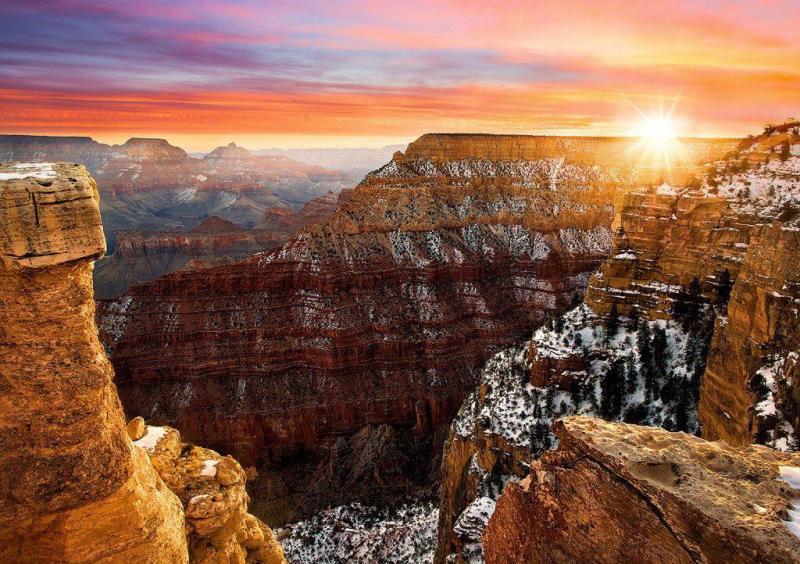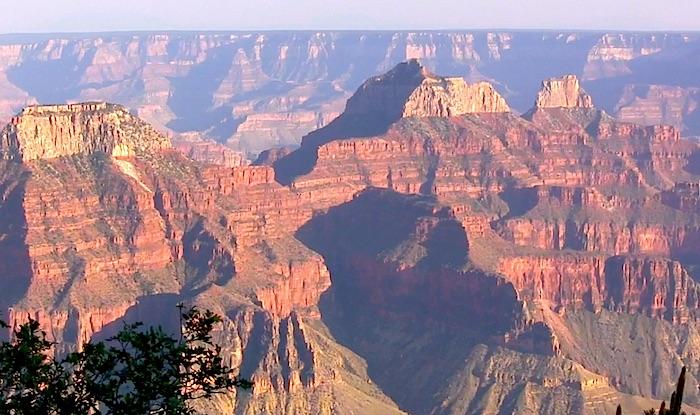
Sunrise at Grand Canyon National Park/NPS
A colorful rift in the earth millions of years -- and immeasurable gallons of water -- in the making, the jagged maw of the Grand Canyon draws crowds content enough to simply stare across this impressive cross-section of geology from either the South or North rim of its namesake national park.
And that can be enough for first-time visitors to Grand Canyon National Park. The rims have numerous vantage points from which to ponder the best morning and evening light, points of interest to gain some understanding of the human history that evolved with the canyon, and resting points to celebrate day’s end over meals and stories of wonderment of this hole in the ground.
But those who venture into that maw are in for even more of a treat. That’s not to diminish the enjoyment of staying atop the rims. But take a short hike down to Ooh-Ahh Point, or perhaps Cedar Ridge along the South Kaibab Trail, or a multi-day trek into the Inner Gorge with stops at Phantom Ranch or perhaps the Bright Angel Campgrounds, and the payoff can be as grandiose as the landscape itself and the experience life-changing.
For some, the trip of a lifetime is had simply floating along the floor of the park in a boat on the Colorado River. You can zoom through, relatively so, on a motor-propelled rig, or spend a glorious three weeks much more slowly drifting on a dory or rubber raft utilized by many outfitters.
But before we get too far into what you can do at Grand Canyon National Park, let's dispense with a little legislative history of this place.
In 1893 President Benjamin Harrison created the "Grand Canyon Forest Reserve," which covered part of today's national park. Then, on January 11, 1908, President Theodore Roosevelt -- after creating the Grand Canyon Game Reserve in 1906 -- turned to the Antiquities Act to create Grand Canyon National Monument. When he did so, Mr. Roosevelt unleashed one of the most memorable quotes in conservation history:
“Let this great wonder of nature remain as it now is,” he declared. “You cannot improve on it. But what you can do is keep it for your children, your children’s children, and all who come after you, as the one great sight which every American should see.”
Finally, Congress in 1919 formally created Grand Canyon National Park.
With that history in mind, let's be honest. You shouldn't spend just one day at Grand Canyon National Park. There's just too much to see and do, particularly if you like to hike.

The view from Grand Canyon Lodge on the North Rim/Kurt Repanshek
The South Kaibab, North Kaibab, and Bright Angel trails are the main thorofares into the canyon, but they lead to many options for sidetrips. You can do a loop of sorts by heading down either the South Kaibab or Bright Angel trails and then diverting onto the Tonto Trail, which connects the two. You could stay atop the South Rim by walking the obviously named Rim Trail. Or you could explore the lower reaches of the North Rim by hiking down the North Kaibab Trail and then turning left onto the Clear Creek Trail. And those are just some of the options.
If you're staying on the North Rim, either in the lodge or the campground, check out the Cape Final Trail. The eminent U.S. geologist Clarence Dutton named the point in 1880 after a 5-mile horseback ride took him to the eastern-most point of the Walhalla Plateau on the rim. He called it, "the most interesting spot on the Kaibab.
On the South Rim, check out the Kolb Studio. Another area landmark, this studio perched on the lip of the rim dates to 1905 and was once the home and business of the Kolb brothers, pioneering photographers at Grand Canyon. The building has been restored and includes free art exhibits and a bookstore. You'll gorgeous artworks inside, along with some of the cameras the brothers used. Each year the Grand Canyon Association uses the building as part of its Grand Canyon Celebration of Art.
Two other intriguing sites on the South Rim are the Desert View Watchtower and Hermit's Rest.
Located at the southeast edge of the national park, the Desert View area provides many visitors with their first introduction and orientation to some of the park's most significant resources, including the Desert View Watchtower and its surrounding historic district. The area also offers spectacular views of the Painted Desert and the Little Colorado River gorge.

Desert View Watchtower, Grand Canyon National Park/NPS, Michael Quinn
Given the significance of the site, its infrastructure, and proximity to neighboring tribal lands, the National Park Service in 2018 proposed to transform Desert View from a traditional scenic overlook and visitor services area into an Inter-tribal Cultural Heritage Site. This would provide opportunities for first-voice cultural interpretation from associated American Indian Tribes-including cultural demonstrations-and enhance visitor orientation to the cultural significance of the site and park while helping inform visitors about tourism opportunities on surrounding tribal lands.
After you explore the watchtower, stop 3 miles to the west at the Tusayan Ruin. A short trail meanders around an area that once was an Ancestral Puebloan village that was a vibrant place 800 years ago. Check at the visitors center to see if a ranger-led tour of the ruin is scheduled during your stay. At the nearby Tuysayan Museum you can examine 2,000–4,000 year old artifacts along with traditional handicrafts made by regional tribes.
Hermit's Rest, meanwhile, is to the west of Grand Canyon Village.
The building, originally constructed as a rest stop for the short stage line that ran from El Tovar to this location, is a stone building placed several feet back from the rim edge, and is tucked into a small man-made earthen mound, built around and atop the building to blend it in with its setting. Hermit's Rest was designed to resemble a dwelling constructed by an untrained mountain man using the natural timber and boulders of the area. From the entrance path a haphazard looking structure of stone and wood greets the visitor, and the approach to Hermit's Rest is marked by a small stone arch set in a stone wall along the original pathway from the parking area to the building. The exposed portions of the building that are not banked into the earth are of rubble masonry bonded with cement mortar, structural logs, and a few expanses of glass. The chimneys are gently battered rubble masonry.-- The National Park Service
Which rim should you visit? For those who have never visited the park, the South Rim is probably a good choice. There are more lodgings there, more interpretive exhibits, and great views into the canyon. And it's open year-round, unlike the North Rim. But there also are great crowds that can take away from your experience.
The North Rim, which usually is open May 15 into November and maybe December depending on snow, is higher in elevation, 8,000 feet to 7,000 feet, has more, and bigger, trees, and still can offer moments of solitude if you plan your hikes away from the middle of the day. It also has fewer people, due to the limited lodging and the task of reaching the North Rim. If you plan to drive from one rim to the other, know that it's roughly a four-hour, 209-mile drive.
There is a wide range of lodging at the park. Everything from $263/night for a queen room at the historic El Tovar down to $112 for a queen room at Maswick Lodge. Want to stay at Phantom Ranch? Get in line. This location on the floor of the canyon with the Colorado River rippling nearby is so popular the concessionaire has resorted to a lottery system for its rooms and cabins. If you win the lottery, you'll be asked to pay $149 for a cabin for two, or $51 for a bunk in the dorm. Meals are extra, of course.
On the North Rim, Grand Canyon Lodge and a nearby campground are your options. The lodge is open May 15-October 15, the campground stays open until snow closes off access to the rim.
Wherever you stay, Grand Canyon is one park you definitely should have on your to-do list.



Add comment